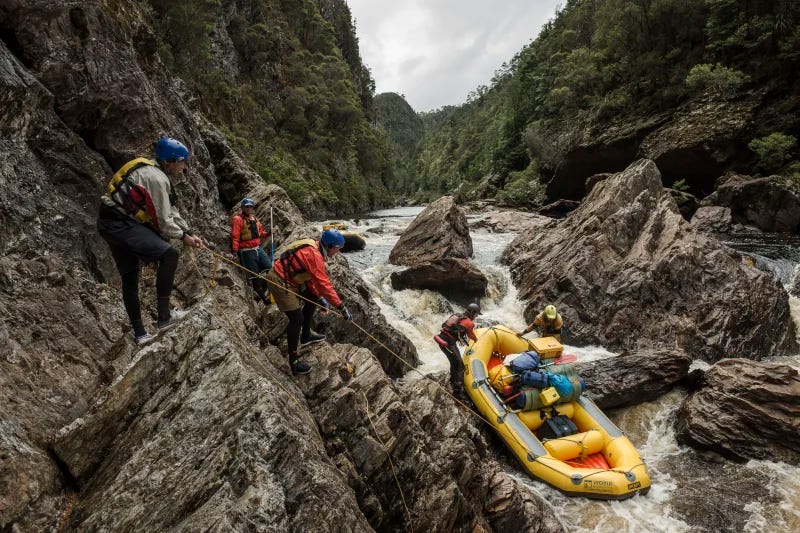I receive Google Alerts about river rafting. Every now and then, something catches my eye and triggers my curiosity and I check it out. This is an exquisite rendering in words - by Konrad Marshall in the Sydney Herald - about river running in general, and the Franklin River in Tasmania, in particular.
I wrote about the Franklin River in a series of columns titled The Ever Varying Flood in the event you missed them. They were spread out over several months this past spring, summer and fall.
The Franklin River was an extraordinarily challenging trip, but the more I look back on it, the more fond I become of that adventure.
I’m taking the day off and I’ll allow Mr. Marshall do the heavy pen-lifting today.
I’ve always preferred rivers to the sea. I think it’s something to do with the way rivers talk – the way their gurgles are like giggles, the way the water slapping onto rocks in a pitter-patter seems like idle chit-chat, and the way their deepest, widest reaches stretch out into an expansive and comfortable silence. Go to the beach and it feels as though the ocean is sharing some absolute truth with you, either roaring at you in waves or ignoring you with ripples. Sidle up to a riverbank, though, and you’re in conversation.
That’s what I thought – or felt – almost four years ago when I dropped into the frigid headwaters of the Franklin River in Tasmania, to begin a week-long rafting trip, floating and paddling and scrambling down a world heritage-listed national treasure – an otherworldly ravine that was mercifully saved from being dammed in 1983. I’ve been to some beautiful places, through forests and deserts and mountains and jungles in Europe and Asia and the Americas, but nothing – nothing whatsoever – compares to the beauty of the Franklin.
The moment you look up and around at where you are, you begin to sense the way this place connects with itself – how the river is formed from the little dewdrops plummeting from tree ferns, which gather into thin trickles along the edge of quartzite cliffs, and how those pour into thick rivulets that run down into the bed of the valley, to form the flowing river upon which you’re now floating downstream, sitting upright in a big yellow inflatable raft.
Sometimes the water was the colour of strong tea, stained that way by the tea trees that line much of its banks, insinuating their roots into the cracks and crags of rocky outcrops and islands, grimly growing small and gnarled there, like bonsai. Other times it gathered in deep black pools, like oil, and little white flower petals swirled on the surface like stars in another galaxy. If I sound as though describing a trance, perhaps I was in one.
You get tired and cold rafting the Franklin, you see. I went in the middle of summer, yet down here on the Apple Isle, subject to the Roaring Forties, I still grew shivery and numb. I got bashed and bruised in this endeavour, dumped and dunked and wearied from paddling all day, then sleeping on rocks under a tarp all night. When signing up for this trip, you have to commit to a certain level of fitness, declaring in a waiver that you’ve done the right amount of exercise in advance. And it’s necessary.
Danger is never far away. As the water cascades it gathers mass, and amasses energy, and as it drops down through rapids with names like Thunderush and Duck Chute it unleashes its frightening force. There are many sections it is simply not safe to go down at all, and so we climbed out of our raft, and scurried up slippery cliffs, or clambered over wet boulders surrounded by furious white water.
Our guides used ropes and ingenuity to “portage” our rafts through the more menacing sections of this place. And they truly are menacing. There are times when you don’t need to be told such things – when you survey the scene and clearly understand that one false step, one slip or stumble, will mean death.
That’s not an exaggeration. Many people have died here, sucked down into the churning waters beneath labyrinthine rock formations. They’ve died at Big Fall, and Pig Trough. The author Richard Flanagan wrote his first novel, Death of a River Guide, based on a drowning at The Cauldron. Flanagan was a river guide himself, and was once almost killed on his kayak after finding himself trapped in an air pocket for hours. To him, the river was “a huge army on the march, overrunning the countryside, taking all before it, collecting ever greater strength from every dripping moss-lined rock face, from every overexcited stream”.
Traveling through this place then teaches you humility, and deference, and resourcefulness. Unlike so many outdoor adventures, the Franklin River experience has not been modulated or mitigated by luxury offerings and accommodations. There are no hidden huts along the way. No points at which helicopters will drop off supplies. No toilet blocks. Not even the most basic lean-to. There is only what you carry with you.
There are no roads or tracks in or out of this place, either. None at all. And it means that once you begin, you must see the trip through to the end. And that’s highlighted by the narrowness of your vision as you make your way down, and the impassable cliffs on either side that reach up to the sky. To see the horizon here is not to peer off into the middle distance, but to look up high, at the barest thin sliver of sky above. On the Franklin, you’re very much hemmed into another world. There’s no hiking out of here – only the imperative to finish.
Rivers are ephemeral, after all. They exist only in motion.
I remember that when I did get near the finish, I felt exhausted but stronger. Exploring caves and chasms covered in fluorescent green moss, I felt as though I understood something more about the richness of things. Surrounded by towering Huon pines and fallen myrtles, like giants’ bones, I felt as though I had learnt something about the scale and scope of life. Rivers are ephemeral, after all. They exist only in motion, and so being on them and in them and feeling their power is a very fleeting thing. I remember someone near the end of our trip coming to that realization, and letting go of a wistful sigh, sad that they would be back in the real world the following morning. The river guide turned and smiled softly, and spoke to us all.
“Mate,” he said, “this is the real world.”
###
To coup or not to coup, that is the question.
Americans believe their vaunted few hundred year old system is immune to banana republic-like skullduggery but many of our fellow citizens who have lived through uncertain times in other countries are begging us to pay attention. To be on guard. To prepare, even when this power grab fails, because the next one will be more difficult to spot.
I remember reading a book about a cellist in Serbia or Croatia when those countries had descended into anarchy. How the cellist continued serenading his neighbors even though he risked being shot by a sniper. I remember the author describing the types of activities - like plays and soccer matches - that continued while the country was ravaged by war and man’s inhumanity to man was daily news.
Because . . . what do you expect people to do? Life goes on.
This is a good article from The Atlantic passed on to me by AAR Steve Laboff written by someone who has seen many types of coups firsthand. Titled ‘This Must Be Your First’.
El Douche, 2020 version.
Also, I have to pass this along in the event you might not have seen it. I first saw New Zealand’s prime minister Jacinda Ardern do this and, in today’s TikTok world, it makes perfect sense. It is Representative Alexandria Ocasio-Cortez giving a rundown of her first term in Congress. We need more public servants in the mold of her and Rep. Katie Porter.







